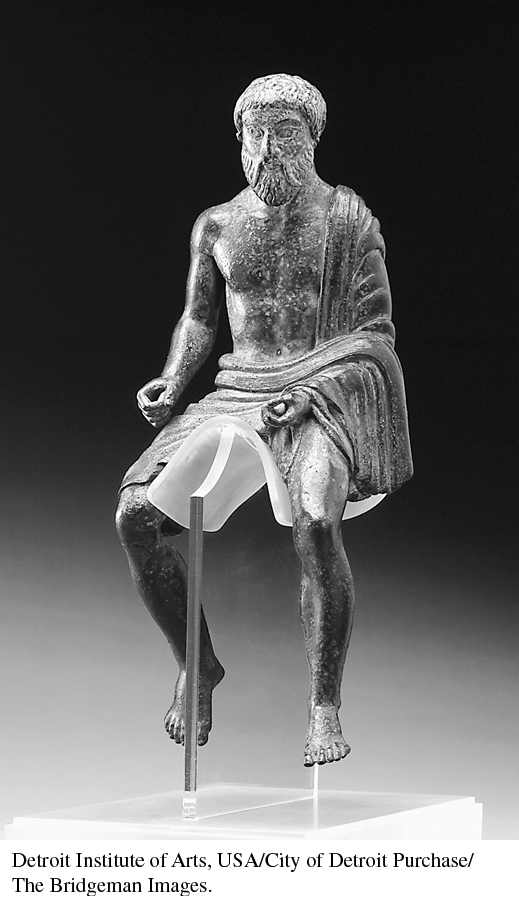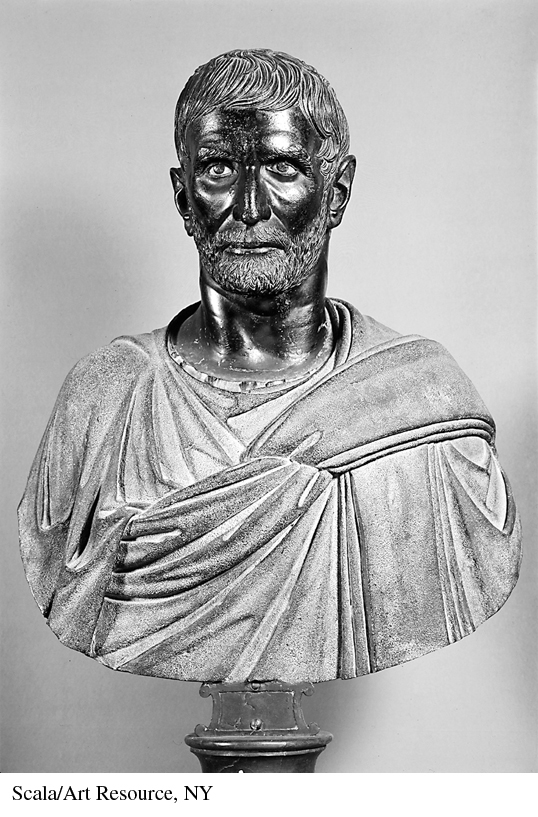2. Artistic Influences
Printed Page 107
Etruscan Statuette of a Rider (c. 434–400 B.C.E.)and
Roman Bust of Lucius Junius Brutus (c. 300 B.C.E.)
Within two decades of its foundation, the Roman republic relied on an aggressive policy of territorial expansion in Italy and abroad to enhance its wealth and power. Unlike the practice of Greek city-states, the Romans absorbed conquered peoples into their population as citizens or allies. In the process, they were also exposed to new forms of art, literature, and language, which helped to shape Rome’s own cultural development. The Etruscans were an especially important cross-cultural influence, as the two images that follow suggest. The first displays a bronze statuette of a male rider, dating from c. 434–400 B.C.E. A wealthy and urbanized people, the Etruscans were fine craftsmen as well as avid importers of luxury goods from throughout the Mediterranean, including Greece. The second, a bust thought to be of Lucius Junius Brutus, one of the founders of the republic, dates from c. 300 B.C.E., after the Roman conquest of Etruscan territory.
From Detroit Institute of Arts; and Capitoline Museums (Palazzo dei Conservatori).


DISCUSSION QUESTIONS
- How would you describe the facial features of the Etruscan rider? How do they compare to those of the bust of Brutus?
Question
How would you describe the facial features of the Etruscan rider? How do they compare to those of the bust of Brutus?
accept_blank_answers: true
points: 10How would you describe the facial features of the Etruscan rider? How do they compare to those of the bust of Brutus? - In choosing to portray human faces in this way, what emotions do you think the sculptors sought to provoke within the viewer?
Question
In choosing to portray human faces in this way, what emotions do you think the sculptors sought to provoke within the viewer?
accept_blank_answers: true
points: 10In choosing to portray human faces in this way, what emotions do you think the sculptors sought to provoke within the viewer? - Unlike the Etruscan statuette, the Roman bust probably depicts a known individual. How do you think this fact may have influenced the sculptor’s design and why?
Question
Unlike the Etruscan statuette, the Roman bust probably depicts a known individual. How do you think this fact may have influenced the sculptor’s design and why?
accept_blank_answers: true
points: 10Unlike the Etruscan statuette, the Roman bust probably depicts a known individual. How do you think this fact may have influenced the sculptor’s design and why?